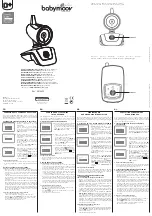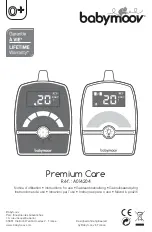
Important Notice
***** MUST READ *****
Page 3 of 4
Fuel Level Accuracy Limitations:
The accuracy limitations of the MVP are listed below.
It is the pilot/owner’s obligation to make anyone
flying the aircraft aware of these limitations.
1. Angle of Attack -
The MVP must be calibrated with the aircraft in a cruise angle of attack. If the aircraft
is in an angle of attack other than cruise, the MVP may display inaccurate fuel levels (depending on the
mounting location and type of sensor used). If your aircraft does not sit at a cruise angle of attack when on the
ground, it may not display accurate fuel levels.
Test your aircraft at different angles of attack to see the
affects on the MVP fuel level readings.
2.
Full Fuel Readings -
As a tank is filled the fuel sensor may not be able to detect the fuel entering the
upper corners of the fuel tank. If this is the case with your sensor, the MVP will display lower fuel levels than
the actual fuel in the tanks when the tanks are full. When the fuel level drops to a point where the fuel sensor
starts to detect a change, the displayed fuel level should be accurate.
Check the accuracy of your system by
comparing the displayed fuel levels on the MVP to the fuel levels listed in the flight manual at each fill
up.
3. Low Fuel Readings - Do not rely on the MVP to determine the fuel level in the tank for an indicated
tank level below 1/8.
You should always fly the aircraft in such a manner as to maintain at least the FAA
minimum fuel requirements in the aircraft at all times.
Depending on the mounting location and type of fuel
sensor used, the MVP may not be able to accurately measure the last few gallons of fuel in the tanks.
4. Improper Calibration -
If the MVP has not been properly calibrated it will not display accurate fuel levels
in the tanks. It is important you verify the accuracy of the MVP.
Always crosscheck your measured fuel
levels in the tanks with the readings on the MVP before each flight.
5. Poor Connections -
Poor connections between the wires leading from the EDC to the fuel sensors can
become intermittent with age. An intermittent connection most likely will show up as wandering or inaccurate
readings on the MVP.
Always crosscheck your measured fuel levels in the tanks with the readings on the
MVP before each flight.
6. Defective Fuel Level Sensors -
Fuel sensors can become intermittent or change resistance with age. It is
not uncommon to find intermittent problems even in new sensors. An intermittent problem with a fuel sensor
most likely will show up as wandering or inaccurate readings on the MVP.
Always crosscheck the measured
fuel levels in the tanks with the readings on the MVP at each fill up.
If you ever find an inaccuracy issue or any other problem with a fuel level display on the MVP, disable
the fuel level display (see the “Redlines, Limits and Color Setup” screen). This will alert anyone flying
the aircraft to the condition of this display.
v
Содержание MVP-50T
Страница 2: ...ii ...
Страница 12: ...xii ...
Страница 14: ...2 ...
Страница 20: ...8 ...
Страница 34: ...22 ...
Страница 36: ...24 ...
Страница 42: ...30 ...
Страница 44: ...32 ...
Страница 48: ...36 ...
Страница 50: ...38 ...
Страница 54: ...42 ...
Страница 61: ...Template for MVP Cutout 49 ...
Страница 62: ...Template for EDC 50 ...
Страница 64: ...52 ...
Страница 72: ...60 ...
Страница 74: ...62 ...
Страница 86: ...STC AML 74 ...
Страница 87: ...75 ...
Страница 88: ...76 ...
Страница 89: ...A1 0 Connecting an EDC Input to a Custom Probe A2 0 Connecting a Second EDC to the MVP A APPENDIX 77 ...
Страница 90: ...78 ...






































